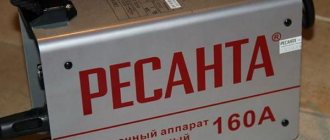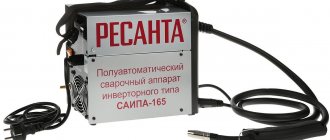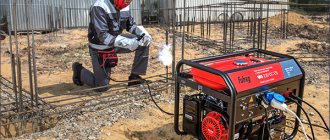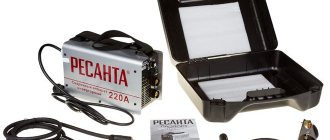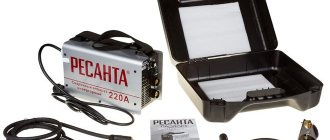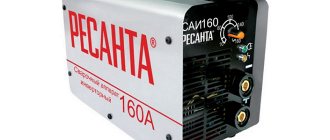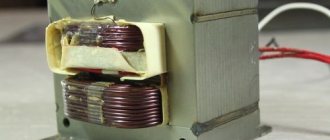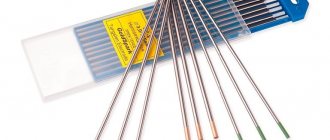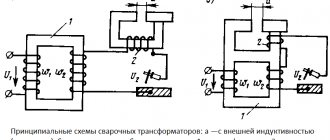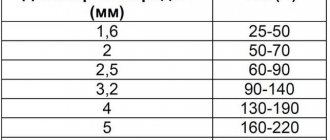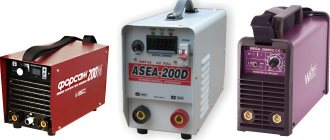The Sai 190 inverter from Resant is a machine for manual arc welding with electrodes of varying intensity. The device was developed by a Baltic manufacturer, but is assembled in China. Operates from a single-phase network with a voltage of 220 V. Smooth adjustment of the current strength is possible depending on the tasks assigned to the welder and the type of electrodes.
The welding inverter is quite easy to operate (compared to transformers) and is capable of operating in 30/70 mode, that is, the device must “rest” for three minutes out of ten.
Calculation of power consumption of a welding inverter
- 10-03-2015
- 41
- 97
The power consumption of a welding inverter is quite easy to calculate using a simple formula. To understand all the nuances associated with the operation of a welder and the aspects of calculating its power, you need to clarify several points that everyone who welds needs to know. And it doesn’t matter where you carry out welding work, at home, in the garage, at the dacha or in a professional team of a large workshop or factory.
Types of welding inverters
Inverter-type devices are divided into three categories. Household inverters are designed for a short duration of switching on and operation from a single-phase alternating current network of 220 V. This means that such a device can only be operated at maximum power for a short time - 20-30 minutes, giving it a rest equal to this time or exceeding it by an order of magnitude. Semi-professional devices allow you to increase operating time from 5 to 8 hours without interruption. For semi-professional inverters, rest time is reduced due to design features. Professional inverters are designed to consume 220/380 V current, often from a three-phase electrical network.
Modern types of welding machines.
Household, semi-professional and some professional welding units are designed to operate from a 220 V network. However, it should be remembered that for household electrical networks the maximum load current cannot exceed 160 A. The power consumption of all accessories, such as sockets, plugs and power circuit breakers, is not calculated to exceed this threshold.
Therefore, connecting an inverter welding machine with higher performance will either trigger the circuit breaker, or cause the contact at the plug-socket interface to burn out, or, most dangerously, lead to the electrical wiring to burn out. This is against all safety regulations. So, when powering a professional unit from a household electrical outlet to operate with a welding current of more than 160 A, be prepared for problems. But it's better not to allow this.
Return to contents
The design of the welding inverter is such that first an alternating voltage of 220 V with a frequency of 50 Hz is converted into direct voltage, and then into an alternating high-frequency voltage with an operating oscillation frequency of up to 200 Hz. After this, the voltage is again converted to constant and supplied to the welding arc. Arc quality control occurs automatically, using the microprocessor filling of the inverter control unit. Electrode sticking, so common when welding using a transformer, practically disappears.
Diagram of the internal structure of the inverter.
For short circuits lasting less than 0.5 seconds, the control unit generates a sequence of short but very powerful current pulses. This leads to the destruction of the resulting liquid metal bridges. When a short circuit lasts 0.5 seconds, the inverter simply turns off without freezing the electrode or overheating the unit circuits. This device is basic for all types of inverters and distinguishes them from transformers and rectifiers based on a diode bridge.
The most important property of a welding inverter is energy consumption. It doesn’t matter what the power consumption of an inverter-type device is, it is almost completely spent on welding. From this we can conclude that the efficiency of the inverter unit is very high. From 85 to 95%.
Return to contents
Before you start calculating the power consumption of an inverter welding machine, you need to know the following:
- Input voltage range.
- Welding current range.
- Welding arc voltage.
- The efficiency of a specific welding machine model.
- Duration of switching on.
- Model specific power factor.
Inverter characteristics
The range of welding current is needed in order to find out under what characteristics of the electric current network we will have to work. It is probably no secret to anyone that often in our electrical networks there is no rated voltage of 220 V. Often it barely reaches 200 V. It should be remembered: the voltage drop when connecting a household-type welding inverter is 5-10% of the total network rating. Therefore, the best power indicators will be found in inverters that are designed for supply voltages from 150-170 V to 220-250 V.
The range of welding current gives us the values of the maximum and minimum levels; the power of the device directly depends on these parameters. For household inverters, these indicators at the lower limit vary from 10 to 50 A, and at the upper limit 100-160 A. The output current voltage, which can also be called the welding arc voltage, ranges for inexpensive household models from 20 to 30 V. The efficiency of Inverters with a maximum output current of 160 A, as a rule, rarely exceed 0.85%. The high efficiency of the welding unit directly depends on the duration of operation.
Return to contents
The power-on duration is a characteristic that shows how high-quality the device you are going to use. This is usually a percentage of the inverter's continuous operating time relative to its total usage time. An indicator of 50% will indicate that when working for 2.5 minutes, the device should rest for 2.5 minutes. The lower the indicator, the longer the circuits must rest and the faster the automatic shutdown relay will operate in case of overheating.
On the contrary, a high percentage will show that the device can be used for a long time, interrupting only to replace the electrodes and check the weld.
Scheme of operation of a welding inverter.
The power percentage is calculated by dividing the continuous operation time by the sum of the continuous operation time and the pause time until the device is turned on again. The result is multiplied by 100. For example, the device worked properly for 3 minutes until the overheating protection tripped, then it was at rest for 2 minutes, after which it was ready for work again:
3 min / (2 min + 3 min) x 100 = 60
The power factor for household or semi-professional inverter-type welding machines rarely exceeds the threshold of 0.6-0.7. You just need to remember this.
All the values needed for calculation can be easily found in the technical documentation for this device, on the manufacturer’s website, or on the casing of the welding machine itself.
Let's imagine that, as an example, we have a welding machine powered by an alternating current network of 160-220 V, having a maximum current value of 160 A with a maximum welding arc voltage of 23 V. The efficiency of this inverter model is 0.89, and the duty cycle indicator, the duration of operation, is 60%.
Now we calculate the maximum power consumption of the inverter with the above parameters. To do this, we first multiply the maximum output current value by the maximum output voltage. We divide the resulting result by the efficiency value of the device.
https://moiinstrumenty.ru/www.youtube.com/watch?v=UX81XigBgBY
160 A x 23 V / 0.89 = 4135 Watts
4.1 kW is the power that the device consumes directly during welding. Average power is calculated by multiplying the maximum power value by the on-time indicator:
4135 Watt x 0.6 = 2481
Average inverter power is the most relevant metric because welding typically does not occur continuously over many hours or days. There are pauses when the welder needs to change the electrode or prepare parts for subsequent processing. Often, welding work can be carried out at a lower current, in which case the total power consumed by the inverter will also decrease. We substitute into the first formula the values that can be set on the console of the welding unit and find the required power parameters.
Return to contents
Table of types of electrodes.
Novice welders often have the question of what diameter electrodes to use for certain output current parameters and metal thickness?
- When the metal thickness is 1-4 mm, electrodes with a diameter of up to 2 mm are used. The current strength set at the output should be selected optimally in the range from 20 to 90 A.
- When the metal thickness is 5-7 mm, electrodes 3 mm in diameter are used. The current strength is set in the range of 90-130 A.
- If the metal has a thickness of 8-12 mm, use 4 mm electrodes. Current strength is in the range of 140-180 A.
- Metal 12-16 mm thick is welded with electrodes 5 mm in diameter at a current of 180-220 A.
- Metal with a thickness of over 15 mm must be exposed to electrodes starting from 6 mm with a current strength of 220 A at the inverter output.
It is better to weld metal with a thickness of more than 15 mm using a gas welding machine.
https://moiinstrumenty.ru/www.youtube.com/watch?v=2Q6BEjCp_t8
The use of electric welding may be unprofitable and high-cost in this case.
moiinstrumenty.ru
Inverter current and generator power: what do you need to know?
Therefore, when choosing a generator for a welding inverter, you should also take into account the maximum current strength. So, for example, if the maximum current strength of the welding inverter is 180A, then you need to multiply them by 25V, not forgetting about the efficiency. Most often, the efficiency of an inverter for welding is 85%, so you can safely take a value of 0.85.
Using this calculation: 180A*25V/0.85=5294 W , it becomes clear that the generator power for a 180A inverter must be at least 5.5 kW. However, ideally, you need to take a generator with at least a 25% power reserve if you have to cook with inverter welding quite often. Therefore, the figure regarding the generator power automatically increases to 6.6 kW and is optimal in this case.
Many people wonder whether it is possible to weld using inverter welding from a 2.5 kW generator . The answer is yes, it is possible, but only for a short time and using for this purpose electrodes no more than 2 mm in diameter, with a current strength on the welding inverter of 30-40A, maximum.
In any case, you must understand that by connecting your inverter to a generator, you can easily cause it to fail, since welding requires high power and loads.
Share on social networks
What should be the power of the welding machine?
- 02-03-2015
- 32
- 73
The power of the welding machine indicates how much current the device can produce and what thickness of metal can be worked with in the future. Professional devices can output from 300 A, but ordinary household ones give less; they are designed to operate at 200-250 A. If the device is needed for one-time repairs or minor construction work, then it is best to take ordinary household ones.
The power of the welding machine indicates what current the device shows and what thickness of metal it is allowed to work with in the future.
In the passport, manufacturers usually indicate only the maximum power consumption, i.e. peak loads and other indicators. It is this parameter that allows you to determine whether the power of the electrical network is sufficient to operate the equipment. We must not forget that when the network voltage drops, many devices are also able to work, but their performance is lower.
What power welding transformer should I choose?
A welding transformer is equipment that can convert the current needed to operate a device. These mechanisms are inexpensive and reliable. The device is used to weld low-alloy steels; consumable electrodes are used for this. When choosing a welding device, you must carefully determine the power.
Scheme of electrical energy conversion in a welding machine.
The maximum values and some margin should be taken into account, since this limit is often exceeded when switching on. For example, if the unit is used to work with a single-phase network, then it is unlikely that it will be possible to exceed the current value of 200 A; we must not forget about this. In fact, this results in the impossibility of using the welding machine.
When choosing, you must remember that the transformer wears out. The higher the value, the higher the heat and wear. If complex and lengthy work is not required, then high power values are completely unnecessary. It is recommended to give preference to equipment that is designed for 120-130 A - this is the optimal middle ground.
Return to contents
A welding rectifier is a type of transformer that allows you to convert alternating current into the direct current necessary for work. Unlike a conventional transformer, a welding rectifier ensures stable combustion and its quality is higher. It is possible to weld non-ferrous metals and thin parts, and no extensive experience is required.
Diagram of the welding machine.
It is not difficult to determine how much power a rectifier must consume to ensure proper and high-quality operation. To do this, you need to know that the standard arc voltage of the device is 24 V. This indicator is multiplied by the value of the welding current, i.e. by 160 A. The figure that will be obtained is the power of the equipment on the arc. Power consumption from the operating electrical network is determined differently. It is necessary to divide the previously obtained result by the efficiency (usually taken as 0.65-0.7). This will be an indicator of the maximum operating current.
When purchasing, it is recommended to always check the value with the declared one, since manufacturers sometimes inflate the indicators in order to sell the device. In reality, the situation is not the best when, when performing work not even at maximum values, severe overheating is observed, and the power drops sharply.
Return to contents
The selection of an inverter welding machine is carried out in accordance with such a parameter as power. The rated current at which the device will operate uninterruptedly without overheating is taken into account, even if the use is intensive. Overheating will not occur even in repeated short-term mode, i.e. at the maximum current value.
Welding machine control.
For example, when using a 3 mm electrode, the operating current will be 120 A. Such conditions will allow you to weld parts 3-4 mm thick. This means that when choosing, you should take into account the power when the inverter can operate with a rated current of 160-180 A, but at the same time having a reserve of 30-50%. Why exactly these values? It is not recommended to operate at maximum values, as this leads to overheating and the inverter fails. When the voltage of the electrical supply network decreases to 170-180 V, the power of the equipment drops, and the welding current is reduced to a minimum. The reserve is needed in case the load is heavy.
A margin is also required when long cables of 5 m or more are used. If the margin is not maintained, the characteristics of the welding machine will drop below the nominal operating level. Such conditions are especially important when cables of 15 m or more are used. When choosing an inverter, it should be taken into account that manufacturers usually overestimate the figures, but in fact the current is at a lower value. What does this lead to? If the characteristics are selected incorrectly, the device overheats during operation and fails, which entails unnecessary financial costs.
Return to contents
Functional diagram of the power source of an inverter welding machine.
A modern semi-automatic machine allows you to perform even the most complex work, for example, high-quality welding of sheet iron and non-ferrous metals. The parameters of this type of device are such that it becomes indispensable when welding thin-layer metals. It is used in auto repair shops where accuracy is high. To obtain the necessary power, gas cylinders can be connected to the equipment, but this is not necessary. It is possible to use cored wire. Some models combine 2 types of equipment - welding generators and semi-automatic machines.
When choosing equipment, you should pay attention to power.
We must not forget about what the power consumption should be at the moment of switching on.
It is always greater than that used during normal operation of the device. Typically, the cost of mechanisms with low power levels is much less. But it is with the help of this device that even the thinnest parts can be welded, and this is important when performing high-precision work.
Return to contents
A combined welding machine is a unit with the functions of a working rectifier or transformer combined with a diesel generator. Such equipment can produce high-frequency or direct current; it is excellent for various types of welding work. This unit allows you to work in the absence of electricity. For example, when building a house on a country site, when the power grid has not yet been connected.
Connection diagrams for welding machines.
In addition to diesel, gasoline generators are used. The characteristics of this device may vary slightly depending on the manufacturer and model, but in general they remain at the same level. When choosing a unit for welding, it is necessary to take into account that they are mainly used on construction sites and for carrying out repair work in conditions where there is no permanent electrical network. Compared to professional ones, they may not be as powerful.
Equipment characteristics:
- The frequency is at 50 Hz.
- The device can operate at alternating voltages of 110 V, 220 V, 230 V, 240 V (you must carefully read the instructions before purchasing).
- The rated power is 4.2 W, and the maximum consumption during operation is 4.8 kW.
- The power of the equipment has a coefficient equal to 1.
- At idle the voltage is 65 V.
- The arc voltage during welding is 25-30 V.
- The welding current of the unit is 180 A.
- The operating current range for uninterrupted operation is 50-180 A.
https://moiinstrumenty.ru/youtu.be/UX81XigBgBY
Power for a welding inverter is an important indicator. It can be different, depending on the type of device and its purpose. When choosing, you should familiarize yourself with the parameters of different welding units in order to purchase the most suitable option.
moiinstrumenty.ru
How much power does a generator need for inverter welding?
A generator for welding must be powerful and reliable, otherwise it will quickly fail. Today, there are various types of generators, synchronous and asynchronous, as well as inverter ones (see website). To connect a welding inverter, you need to purchase only an asynchronous generator running on gasoline or diesel fuel.
Now, as for the power of the generator, it, as mentioned above, should be selected with a small margin ( 20-25% ) so that the generator does not go into protection when connecting welding. The power of the generator should be selected based on the power of the welding inverter connected to it. You can find out the power of the inverter in its documentation. However, one should not confuse kW and kVA , since these are completely different values.
How to convert kVA to kW
- kVA is the rated power of an electrical appliance;
- kW - active power.
Very often, in the passport for a welding inverter, the power is indicated not in kW, but in kVA, so you need to be able to convert kVA to kW. To do this, just use the following example, where 10 kVA * 0.8 = 8 kW . Thus, after the necessary calculations, it becomes clear exactly how much the welding inverter consumes in the load.
In this case, you need to take into account the welding current that the inverter produces. The higher the welding current, the more the inverter will create a load on the power grid or work at the limit of its capabilities. Therefore, if you need to cook with 3 or 4 mm electrodes from a generator, then you need to be prepared for the fact that a 2.5-3 kW generator will be absolutely unsuitable for these purposes.
Resanta SAI 250 PROF is an inverter with optimal energy consumption
The welding inverter Resanta SAI 250 PROF is a new product for 2012 in the model range of welding inverters and is part of the SAI-PROF line. This line is distinguished by more efficient use of input voltage (increased efficiency and expanded input voltage range from 100 to 260V).
It should also be noted that it is possible to use electric generators with a power 15 percent lower than for conventional welding inverters (for this model, a generator with an output power of 6.5 kW is sufficient). This is all provided by the power factor corrector (PFC function).
The use of the Resanta SAI 250 PROF welding inverter makes it possible to ensure optimal consumption of mains current in a sinusoidal manner, which reduces the sag of mains voltage, and also creates less electromagnetic interference and achieves energy savings of 30 percent. The principle of operation is based on the conversion of 220V mains voltage with a frequency of 50Hz into direct voltage, followed by the conversion of direct high-frequency alternating voltage.
Features of the welding inverter
- Provides operation from a 220V network with a conventional electrode up to 5mm.
- There are two regulators on the front panel, one regulates the welding current smoothly, the second regulates the “afterburner” of the welding arc, increasing its stability.
- Has a digital display displaying the welding current value.
- Has a wide range of input voltage, from 100 to 260V.
- The device is equipped with anti-sticking and hot start functions.
- IGBT transistors are used in manufacturing.
- Forced tunnel cooling.
- Protection class IP21.
Technical characteristics of Resanta SAI 250 PROF
- Voltage – 220V.
- Generator power – 6.5 kW.
- Open circuit voltage - 65V.
- Load duration - 70%, 250A
- The maximum diameter of the electrodes used is 5.0 mm.
- The minimum diameter of the electrodes used is 1.6 mm.
- Maximum welding current – 250A.
- The minimum welding current is 10A.
- Current consumption - 38A
- Arc voltage 28V.
- Weight – 6.0 kg.
Resanta SAI 250 PROF is equipped with a cable (2 m) with an electrical holder and a cable (1.5 m) with a ground clamp.
kovka-svarka.net
Resanta welding machines – which one to choose
“Resanta” is an extremely popular brand in Russia under which welding equipment is produced. The products are presented in four lines and include inverter and semi-automatic models, as well as plasma cutters.
Types of welding machines "Resanta"
Four series of Resanta welding machines have been developed: SAI-220K, SAI-220, SAI-220PN, SAI-250PROF. They are united by a number of useful functions: protection against overheating, anti-sticking of electrodes, “hot” start, arc force. The first difference is in dimensions and weight - the devices of the SAI-220K series have the smallest ones. The second is in the input voltage range. For the first three lines it is 140–260 V, for the fourth – 100–260 V. The third difference lies in the additional equipment: representatives of the SAI-220PN and SAI-250PROF lines have a digital display and a welding cable included.
Rating of popular Resanta models
"Resanta" SAI-250K is a compact inverter model in a 4.6-kilogram body. Suitable for professional use. Supports electrodes with diameters from 2 to 6 mm. Power consumption is 7.7 kW, minimum current is 10 A. During operation it ensures a neat, even seam. Due to its low weight and modest size, the device is very mobile, which makes it suitable for high-altitude welding work. The forced ventilation system allows the inverter to be used in industries with high levels of pollution.
"Resanta" SAI-220 is a high-performance inverter device for household and semi-professional use. Housed in a lightweight, impact-resistant case and equipped with a shoulder strap for easy portability. Designed for manual DC arc welding with 1.6–5 mm stick electrodes with special coating. Power consumption – 6.6 kW, minimum current – 10 A. Suitable for ferrous metals, stainless steel and copper in sheets from 0.3 mm. Forced ventilation, as in the previous model, is provided by three powerful fans.
“Resanta” SAI-160K is an inverter designed to operate from a 220 V household network. A small transformer and IGBT-type transistors make its body light (3.4 kg) and compact; a shoulder strap is used for carrying from place to place. In pairs with the device, you can use AC or DC electrodes with a diameter of 1.6 to 4 mm. The power consumed in operation is 4.8 W, the minimum current is 10 A. A special feature of this model is the large value of the open circuit voltage parameter (80 V). This allows you to quickly ignite an electric arc and makes the inverter suitable for working with non-ferrous metals.
"Resanta" SAIPA-165 is a semi-automatic inverter welding machine. Uses special wire with a diameter of 0.6–0.9 mm for welding. Its feeding starts automatically after pressing the button located on the handle of the case (weight 11.5 kg). A protective gas environment from a cylinder is used as a replacement for flux. Power consumption is 4.8 kW, minimum current is 20 A. The model has a cooling system that maintains the temperature at a given level, as well as forced ventilation. The device is distinguished by smooth adjustment of operating parameters and the absence of additional load on the electrical network at the time of ignition.
i-stab.ru
